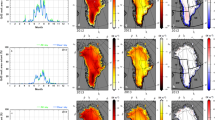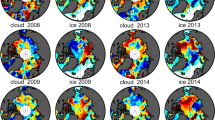Abstract
Melting of the world’s major ice sheets can affect human and environmental conditions by contributing to sea-level rise. In July 2012, an historically rare period of extended surface melting was observed across almost the entire Greenland ice sheet1,2, raising questions about the frequency and spatial extent of such events. Here we show that low-level clouds consisting of liquid water droplets (‘liquid clouds’), via their radiative effects, played a key part in this melt event by increasing near-surface temperatures. We used a suite of surface-based observations3, remote sensing data, and a surface energy-balance model. At the critical surface melt time, the clouds were optically thick enough and low enough to enhance the downwelling infrared flux at the surface. At the same time they were optically thin enough to allow sufficient solar radiation to penetrate through them and raise surface temperatures above the melting point. Outside this narrow range in cloud optical thickness, the radiative contribution to the surface energy budget would have been diminished, and the spatial extent of this melting event would have been smaller. We further show that these thin, low-level liquid clouds occur frequently, both over Greenland and across the Arctic, being present around 30–50 per cent of the time3,4,5,6. Our results may help to explain the difficulties that global climate models have in simulating the Arctic surface energy budget7,8,9, particularly as models tend to under-predict the formation of optically thin liquid clouds at supercooled temperatures6—a process potentially necessary to account fully for temperature feedbacks in a warming Arctic climate.
This is a preview of subscription content, access via your institution
Access options
Subscribe to this journal
Receive 51 print issues and online access
$199.00 per year
only $3.90 per issue
Buy this article
- Purchase on Springer Link
- Instant access to full article PDF
Prices may be subject to local taxes which are calculated during checkout



Similar content being viewed by others
References
Buis, A. & Cole, S. Satellites see unprecedented Greenland Ice Sheet melt. (NASA/JPL press release, 24 July 2012); available at http://www.jpl.nasa.gov/news/news.cfm?release=2012-217 (2012)
Nghiem, S. V. et al. The extreme melt across the Greenland Ice Sheet in 2012. Geophys. Res. Lett. 39, L20502, http://dx.doi.org/10.1029/2012GL053611 (2012)
Shupe, M. D. et al. High and dry: new observations of tropospheric and cloud properties above the Greenland Ice Sheet. Bull. Am. Meteorol. Soc. 94, 169–186 (2013)
Turner, D. D. et al. Retrieving liquid water path and precipitable water vapor from the atmospheric radiation measurement (ARM) microwave radiometers. IEEE Trans. Geosci. Remote Sensing 45, 3680–3690 (2007)
Shupe, M. D. et al. Clouds at Arctic atmospheric observatories. Part I: occurrence and macrophysical properties. J. Appl. Meteorol. Climatol. 50, 626–644 (2011)
Cesana, G., Kay, J. E., Chepfer, H., English, J. M. & de Boer, G. Ubiquitous low-level liquid-containing Arctic clouds: new observations and climate model constraints from CALIPSO-GOCCP. Geophys. Res. Lett.. 39, L20804, http://dx.doi.org/10.1029/2012GL053385 (2012)
de Boer, G. et al. A characterization of the present-day Arctic atmosphere in CCSM4. J. Clim. 25, 2676–2695 (2012)
Klein, S. A. et al. Intercomparison of model simulations of mixed-phase clouds observed during the ARM mixed-phase Arctic cloud experiment. I: Single-layer cloud. Q. J. R. Meteorol. Soc. 135, 979–1002 (2009)
Sandvik, A., Biryulina, M., Kvamsto, N. G., Stamnes, J. J. & Stamnes, K. Observed and simulated microphysical composition of arctic clouds: data properties and model validation. J. Geophys. Res.. 112, D05205, http://dx.doi.org/10.1029/2006JD007351 (2007)
Serreze, M. C. & Barry, R. G. Processes and impacts of Arctic amplification: A research synthesis. Global Planet. Change 77, 85–96 (2011)
Mernild, S. H., Mote, T. & Liston, G. E. Greenland ice sheet surface melt extent and trends: 1960–2010. J. Glaciol. 57, 621–628 (2011)
Clausen, H. B., Gundestrup, N. S., Johnson, S. J., Bindschadle, R. & Zwally, J. Glaciological investigations in the Crete area, central Greenland: a search for a new deep drilling site. Ann. Glaciol. 10, 10–15 (1988)
Ohmura, A. Physical basis for the temperature-based melt-index method. J. Appl. Meteorol. 40, 753–761 (2001)
Hudson, S. R. & Brandt, R. E. A look at the surface-based temperature inversion on the Antarctic plateau. J. Clim. 18, 1673–1696 (2005)
Brandt, R. E. & Warren, S. G. Temperature measurements and heat transfer in near-surface snow at the South Pole. J. Glaciol. 43, 339–351 (1997)
Bintanja, R. & van den Broeke, M. The influence of clouds on the radiation budget of ice and snow surfaces in Antarctica and Greenland in summer. Int. J. Climatol. 16, 1281–1296 (1996)
Brandt, R. E. & Warren, S. G. Solar-heating rates and temperature profiles in Antarctic snow and ice. J. Glaciol. 39, 99–110 (1993)
Turner, D. D. Improved ground-based liquid water path retrievals using a combined infrared and microwave approach. J. Geophys. Res.. 112, D15204, http://dx.doi.org/10.1029/2007JD008530 (2007)
Turner, D. D. et al. Thin liquid water clouds — their importance and our challenge. Bull. Am. Meteorol. Soc. 88, 177–190 (2007)
Steffen, K. & Box, J. Surface climatology of the Greenland ice sheet: Greenland climate network 1995–1999. J. Geophys. Res. D 106, 33951–33964 (2001)
Intrieri, J. M. et al. An annual cycle of Arctic surface cloud forcing at SHEBA. J. Geophys. Res.. 107, 8039, http://dx.doi.org/10.1029/2000JC000439 (2002)
Shupe, M. D. & Intrieri, J. M. Cloud radiative forcing of the Arctic surface: the influence of cloud properties, surface albedo, and solar zenith angle. J. Clim. 17, 616–628 (2004)
Pavolonis, M. J. & Key, J. R. Antarctic cloud radiative forcing at the surface estimated from the AVHRR Polar Pathfinder and ISCCP D1 datasets, 1985–93. J. Appl. Meteorol. 42, 827–840 (2003)
Persson, P. O. G. Onset and end of the summer melt season over sea ice: thermal structure and surface energy perspective from SHEBA. Clim. Dyn. 39, 1349–1371 (2012)
Cox, C. J., Walden, V. P. & Rowe, P. M. A comparison of the atmospheric conditions at Eureka, Canada, and Barrow, Alaska (2006–2008). J. Geophys. Res.. 117, D12204, http://dx.doi.org/10.1029/2011JD017164 (2012)
Ohmura, A. et al. Baseline Surface Radiation Network (BSRN/WCRP): new precision radiometry for climate research. Bull. Am. Meteorol. Soc. 79, 2115–2136 (1998)
Munneke, P. K. et al. The role of radiation penetration in the energy budget of the snowpack at Summit, Greenland. Cryosphere 3, 277–306 (2009)
Acknowledgements
ICECAPS is supported by the US National Science Foundation (grants ARC-0904152, 0856773 and 0856559) as part of the Arctic Observing Network (AON) programme. Two-metre temperature and radar measurements were provided by the NOAA Earth System Research Laboratory. Lidar and ceilometer measurements were provided by the Department of Energy Atmospheric Radiation Measurement programme. We thank the extended ICECAPS team of scientists, engineers, students and field technicians for obtaining high-quality atmosphere and cloud observations at Summit.
Author information
Authors and Affiliations
Contributions
R.B. conceived this study, developed the surface temperature model, and performed most of the data analysis; M.D.S. coordinated ICECAPS measurement streams and contributed to interpretation of cloud-surface interactions and Arctic cloud context; D.D.T. performed the physical retrievals to derive precipitable water vapour and liquid water path from the microwave radiometers, and analysed the cloud height distributions over Summit for the three July periods; V.P.W. served as Principal Investigator for the ICECAPS project, and oversaw the calculation of longwave downwelling clear-sky and all-sky fluxes; K.S. provided the broadband radiative flux observations; C.J.C. calculated longwave downwelling clear-sky fluxes from radiosonde observations and all-sky fluxes from spectrally highly resolving infrared observations; M.S.K. provided support developing multi-frequency microwave radiometer retrievals and retrieving/analysing operational datasets; N.B.M. provided ceilometer derived cloud fraction calculations and collected various operational datasets; and C.P. helped operate the radar, and helped identify the MODIS data and other observational datasets.
Corresponding author
Ethics declarations
Competing interests
The authors declare no competing financial interests.
Supplementary information
Supplementary Information
This file contains Supplementary Text and Data: 1) Observational data and information flow overview; 2) Detailed description of the prognostic surface energy balance model a) Parameterization of temperature Profile in the surface layer b) Representation of physical processes c) Parameter choices i) Atmospheric heat fluxes and relaxation time scale ii) Ground heat flux relaxation time scale iii) Advection d) Simplifications and assumptions made; 3) Parameterization of radiative fluxes at the surface a) Longwave fluxes b) Shortwave fluxes; 4) Additional information on observations at Summit a) Cloud fraction statistics at Summit b) Liquid water path statistics c) Comparison of observed and simulated fluxes; 5) Comparison of simulated and observed surface temperatures for additional months; 6) Information on additional observational sites; 7) Acronyms and Symbols a) Acronyms b) Symbols 8) Additional References. This file also contains Supplementary Figures 1-10, Supplementary Tables 1-3 and additional references. (PDF 2082 kb)
Rights and permissions
About this article
Cite this article
Bennartz, R., Shupe, M., Turner, D. et al. July 2012 Greenland melt extent enhanced by low-level liquid clouds. Nature 496, 83–86 (2013). https://doi.org/10.1038/nature12002
Received:
Accepted:
Published:
Issue Date:
DOI: https://doi.org/10.1038/nature12002
This article is cited by
-
Synoptic and planetary-scale dynamics modulate Antarctic atmospheric river precipitation intensity
Communications Earth & Environment (2024)
-
Firn on ice sheets
Nature Reviews Earth & Environment (2024)
-
The Processes-Based Attributes of Four Major Surface Melting Events over the Antarctic Ross Ice Shelf
Advances in Atmospheric Sciences (2023)
-
Uncertain role of clouds in shaping summertime atmosphere-sea ice connections in reanalyses and CMIP6 models
Climate Dynamics (2023)
-
Decreasing surface albedo signifies a growing importance of clouds for Greenland Ice Sheet meltwater production
Nature Communications (2022)
Comments
By submitting a comment you agree to abide by our Terms and Community Guidelines. If you find something abusive or that does not comply with our terms or guidelines please flag it as inappropriate.



